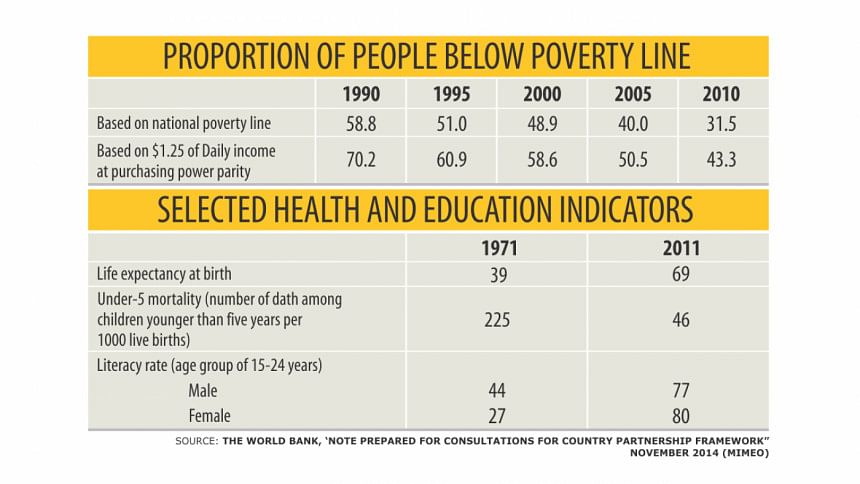Poverty alleviation: Where we go from here?

Bangladesh has earned considerable reputation for achieving remarkable success in reducing poverty not merely in its income/consumption dimension, but also in terms of health and education indicators of poverty. Nevertheless, as the subsequent analysis will show, there is no scope for complacency. We still have a long road to travel in our quest for elimination of poverty. Besides, many of our neighboring countries have done even better.
The progress
The table illustrates the progress in achievement. The proportion of people below the national poverty line has been nearly halved between 1990 and 2010. However, if the poverty line is based on purchasing power parity daily income of USD 1.25, the progress is considerably slow. The achievements in terms of life expectancy at birth, under-5 mortality rate and literacy rate both among males and females are obviously laudable.
In spite of reasonably satisfactory progress, Bangladesh cannot afford to dilute its focus on poverty alleviation. One reason is that, given a very large size of our population, the number of people below the national poverty line remains huge. Assuming that the recent trend continues, the proportion of people below the poverty line should be about 25 percent in 2014. In that event, the number of poor people in Bangladesh would be nearly double the entire population of Sri Lanka.
Another reason why Bangladesh should sharpen its focus on poverty alleviation is that the incidence of poverty remains quite high. The latest available data from the World Bank show that the proportion of people below the line in Bangladesh, even when measured in terms of the national poverty line, is considerably higher than in the neighbouring countries such as China, India, Indonesia, Malaysia, Philippines, Sri Lanka, Thailand and Vietnam.
The drivers of poverty alleviation in Bangladesh
1. Growth acceleration: An important contributor to poverty alleviation in Bangladesh has been the acceleration of growth. It is well known that growth reduces poverty through a number of channels. It creates employment opportunities (including for the poor, unskilled workers). It generates more resources for the government to deploy provisions of public services such as elementary education, primary health care, rural infrastructure etc. which benefit the poor. Growth also enables a government to devote more resources to expand the coverage of social safety net programmes to redress the plight of the poor. In Bangladesh GDP growth has accelerated by about one percentage in every decade since the 1980s. Many cross-country empirical studies also substantiate the effectiveness of growth as a potent tool for poverty alleviation.
2. Labour intensive exports: The rise of labour intensive exports has played an important role in ameliorating poverty. The export of garments can be singled out in this context. Total export as a proportion of GDP rose from 7.5 percent in fiscal year 1993-94 to 20.7 percent in fiscal year 2012-13 and the share of garments in total exports in the respective years rose from less than 45 percent to well over 80 percent. The garments industry overwhelmingly employs women, most of whom come from relatively poor families. This industry contributes to poverty alleviation not merely by creating income-earning opportunities for the poor, but also by delaying marriages and reducing the family size of poor households.
3. Remittances: Available evidence shows that remittances help reduce poverty by increasing consumption as well as savings by poor households. Here again Bangladesh has made remarkable strides. During the period of 1990 to 2010, remittances grew by a compounded annual growth rate of 13.2 percent, notably higher than some of the important labour exporting neighbouring countries such as Indonesia, Pakistan and Sri Lanka. In absolute terms, the amount of remittance was USD 761 million in the fiscal year 1989-90; it rose to USD 14,461 million in 2012-13. The growth was uninterruptedly positive in every single year during this entire period.
4. Microcredit: Bangladesh is recognised throughout the world as a pioneer in microcredit. Some criticisms notwithstanding, it cannot be denied that microcredit contributed significantly to poverty reduction. A recent empirical study has concluded that microcredit programmes helped participants earn higher income, consume more and thereby lifted many of them out of poverty. The reduction of poverty, in particular the reduction of extreme poverty, could be as high as 9 percent of total poverty reduction over the last decade in Bangladesh.
5. Social safety net programmes: Another recent empirical study finds that the impact of social safety net programmes implemented by the government on poverty reduction is mixed. However, programmes which are oriented towards employment did contribute positively towards reduction of poverty.
6. Other things co-related to poverty: Empirical studies in Bangladesh show that the higher the educational status of the head of the household, the lower is the level of poverty. Health status is also an important determinant of poverty. Health shocks can cause people above poverty line to go below it and intensify the poverty of those who are already at a lower level. It has also been found that the greater the opportunities for non-farm work near villages, the lower is the incidence of poverty. There is a regional dimension of poverty as well. As of 2010 the proportion of people below poverty line was 39.4 percent in Barisal Division, 35.7 percent in Rajshahi Division (including Rangpur), 32.1 percent in Khulna Division, 30.5 percent in Dhaka Division, 28.1 percent in Shylet Division and 26.2 percent in Chittagong Division.
Where to go from here
In light of the preceding analysis the following actions are suggested to achieve faster pace in poverty alleviation.
- Accelerate GDP growth. In order to accomplish this we must increase both domestic private investment and foreign direct investment. Besides, public investment has to be increased with a view of addressing energy and infrastructure deficit and creating special economic zones to redress the problem of availability of land. Without significant improvement in these areas, private sector investment will remain constrained.
- The emphasis on labour intensive exports should continue. Efforts should be made to expand the basket of export goods (including ICT-enabled services) and diversify markets alongside improvements in the quality of products.
- The scope for enhancing remittances should be explored with all seriousness. This would require solving problems being currently faced in the countries which are major destinations for Bangladesh migrant workers, finding new markets, and upgrading the skill of the migrants which could increase per capita remittance.
- Microcredit operations should be expanded while ensuring that no abusive practices take place. Bangladesh Bank and Microcredit Regulatory Authority could play a more proactive role.
- The need for expanding social safety net programmes, the allocation for which has been falling as proportion of the total budget since fiscal year 2008-9, cannot be over emphasised. At the same time, the government has to ensure that the programmes are truly targeted to the poor and prevent leakages. The leakages occur in the form of selection of beneficiaries who are not entitled, exclusion of those who are entitled, and outright misappropriation.
- The prevailing gap between the rich and poor sections of the population in terms of educational and health status has to be bridged. A recent World Bank study notes that in Bangladesh student achievement in English was 250 percent higher among the richest quintiles than among the poorest and the difference was more than 100 percent in math competency. Similarly, there was a wide gap in terms of health status as indicated by neonatal mortality (defined as number of deaths within first 28 days per thousand live births), under-five mortality (number of deaths among children younger than five years per 1000 live births) and stunting (percentage of children younger than two years whose height for their age is below the World Health Organisation standard).
- Expanded opportunities for non-farm employment in rural areas. In this area, the government needs to actively enlist the support of private sector investors.
- Regional disparities must be addressed. In this context, it may be noted that the last Caretaker Government had prepared a report under the aegis of the Planning Commission. The title of the report was “A strategy for poverty reduction in the lagging regions of Bangladesh”. The recommendations included redirecting social safety net programmes, more allocation for employment-focused activities, enhanced block allocation for local government institutions, greater attention to solve deficiencies in transport, electricity, gas, storage facilities etc., promoting migration and development of eco-tourism.
- Finally, all of the above actions have to be underpinned by uninterrupted political stability the absence of which is inimical to investment and growth. Moreover, the absence of political stability, often accompanied by street violence, hurts the poor most. Small farmers get low prices for their produce, day labourers do not get employment, transport workers suffer physically and small retail shopkeepers are afflicted by significant loss of sales.
The writer is a former Adviser to the Caretaker Government, Ministries of Finance and Planning and presently a visiting Professor in BRAC University.

 For all latest news, follow The Daily Star's Google News channel.
For all latest news, follow The Daily Star's Google News channel. 



Comments